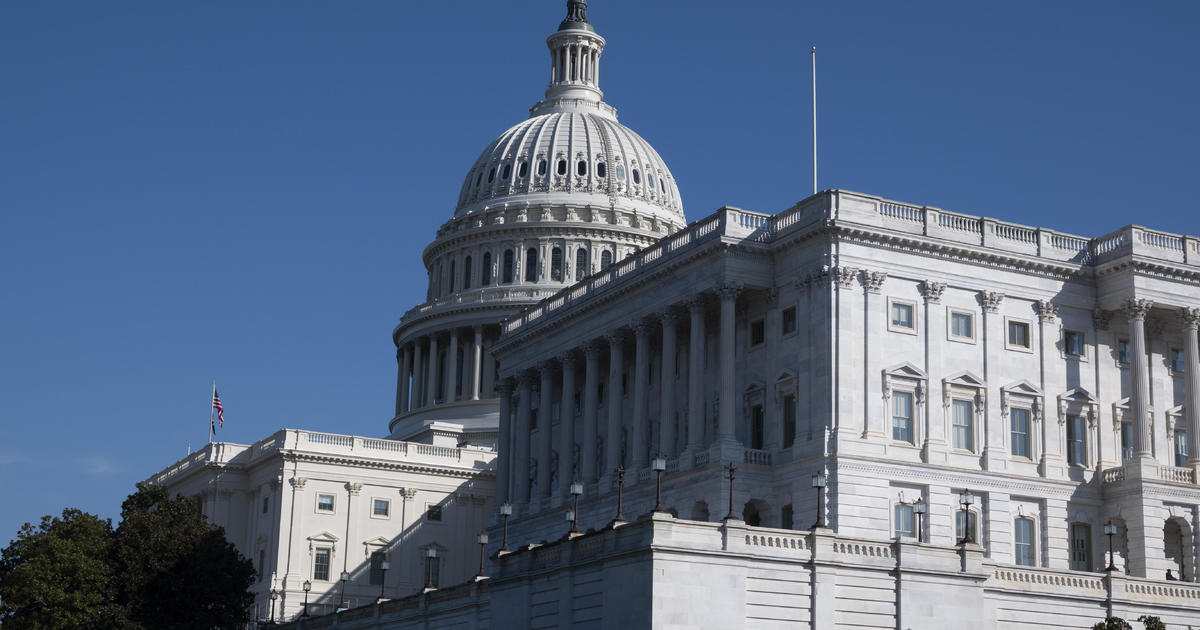All 50 states have finished their congressional maps - what do they say about the 2022 election?
All 50 states have finalized their congressional map to use for elections this November, a major checkpoint in the once-a-decade process of redrawing lines for political representation.
New Hampshire on Tuesday became the last state to fully enact its map, and while Florida, Texas, Alabama and a few other states are still waging legal battles over partisan and racial gerrymandering, the maps they've enacted will remain in place for this year's midterm elections.
Here's what the maps tell us about what to expect in the 2022 midterm elections:
Democrats made up some ground
Compared to the maps used in the 2020 U.S. House elections, Democrats are expected to see a net gain of ten seats that will favor their party by at least 5 points, according to a CBS News analysis of election data from Dave's Redistricting App.
In total, 181 seats lean toward Democrats, 173 seats lean toward Republicans and 81 seats are considered competitive (within 5 points for both parties), according to a CBS News analysis.
The result is the fairest map the party believes it has seen in the last three decades.
Though Democrats had the power to redraw fewer seats than Republicans (187 seats to 75 seats), they were still able to make up some ground by aggressively pressing their advantage in states like Oregon and Illinois, where they control the legislature. Legal victories in North Carolina's and Pennsylvania's Supreme Courts and independent commissions in California and Michigan also helped them gain an edge.
Reapportionment, the process that determines which states gain or lose congressional districts based on their census data, also resulted in more Democratic states that lost a seat (New York, Illinois, California) than Republican states (West Virginia, Ohio).
Kelly Ward Burton, president of the National Democratic Redistricting Committee, thinks the party has a clear advantage on the map that can last the rest of the decade. She said their numbers show 215 districts on the new map where Biden won more than 52% of the vote, compared to 196 seats where he had less than 48%.
But when a heavy Democratic gerrymander was thrown out in New York at the same time Republicans in Florida successfully mapped a gerrymander that aims to give them four more seats in Congress, Democrats saw their edge from redistricting shrink.
"At the DCCC, I understand how difficult that [New York] map may be for 2022 incumbents and the work that has to be done in 2022. But when you pull out and look at the map in the full landscape of the decade, I think that map is going to be fine for Democrats," Burton said.
"The redistricting story is different than the 2022 story. Because the thing about redistricting is setting the table for the decade. That map is the map for '22, it's also the map for '24 and '26," she added.
And any gains Democrats made may not be readily apparent, especially if Republicans take the House by a large margin.
"From the outset, Republicans were never going to rely on redistricting to win the majority. We've said from the beginning that we needed great candidates, a winning message and enough resources to make history and fire Nancy Pelosi," said National Republican Congressional Committee spokesperson Michael McAdams.
McAdams added that regardless of the new maps, the current political environment "has created a tremendous amount of opportunities for Republicans to win. When you're looking at Joe Biden's performance and his numbers with independents, there's a tremendous opportunity for Republicans."
Adam Kincaid, president of the National Republican Redistricting Trust, said that Democratic legislators "overextended themselves" in Nevada, Illinois, Oregon and New Mexico by drawing districts that may have voted more Democratic in past elections, but are well within Republican reach this November.
He pointed to Nevada in particular, and called it the "dummymander" of the cycle. In Nevada, the Democratic majority "unpacked" or siphoned off some voters from the heavily Democratic 1st District in order to shore up the 3rd and 4th Districts, which both have Democratic incumbents.
"Democrats were trying to draw as many seats they could at Biden +8 to Biden +12. And I don't see those seats holding up this fall," he said.
"Let's accept the premise that they do [win those Nevada seats]," responded Burton. "Say it's a bad cycle. Democrats can get it right back in a presidential year, and in a better cycle, because the voters get to decide the outcome of those elections. By definition, that's how it should be."
Kincaid added that their numbers show the states with an independent or bipartisan commission were a "wash" for both parties, which he said was a "big win."
Republicans show gains in heavily pro-Trump seats
The NRRT's numbers also showed that in the 18 states where Republicans had control, they increased the number of seats that heavily favored former President Donald Trump (by at least 10 points in 2020) by 17 seats. They were able to do that through states like Texas, which shored up its incumbent Republicans by drawing more rural areas into their districts, at the cost of competitive seats.
On the whole map, the NRRT's numbers show an increase of 11 strong Trump seats compared to an increase of 2 strong Biden seats. Kincaid said that raises the floor for House Republicans and that it enables them to focus and spend more money on offensive targets and less on defending incumbents.
"Republicans have a much better shot at regaining votes in the suburbs than Democrats do in regaining votes in rural areas. I think that all we've done is we've given ourselves the ability to build on our coalition while they're hoping their Biden coalition sticks together. And I don't see any signs of that happening right now on their side," he said.
Competitive seats decline
The number of competitive districts (those that have a +/- 5 point partisan lean) decreased by ten, according to a CBS News analysis. Redistricting experts and analysts warn that the steady decline of competitive House races in recent decades creates an outsized role for primary elections.
And that could result in an even more partisan and polarized U.S. House.
"Everything in much of the country comes down to the primary now and primary electorates are a tiny share of the general election electorate. And those are the deciders," said Michael Li, a redistricting expert at the Brennan Center. "There will be a lot less competition for the foreseeable future."
While Republican states like Texas and Georgia effectively took competitive seats off the board by drawing more rural areas into suburban districts, moderate Republican members of Congress such as Adam Kinzinger of Illinois and John Katko of New York were also forced to retire because of the Democratic maps in their respective states.
Democrat Carolyn Bouredeaux of Georgia, seen as a centrist Democrat, was forced into an incumbent vs. incumbent matchup in the state's now reliably blue 7th District. She lost to Rep. Lucy McBath, a more progressive Democrat and advocate against gun violence.
Tim Persico, executive director of the Democratic Congressional Campaign Committee, said while their numbers show a decline of competitive seats, "cycle over cycle, what is competitive changes all the time."
"Quote-unquote competitive can mean different things in different cycles, but largely it's the same number of seats so our work doesn't change all that much," he said. "We entered into this cycle with the objective of coming out of redistricting with a map that we can win on, and I think we feel pretty good that we have a map that we can win on."
The NRRT said there is a decrease of 13 seats that were within 10 points in 2020 for Trump or President Biden in the new map. The NDRC found just 31 seats that fit their definition of competitive, which is within two points of 50% on a generic partisan scale.
Minority communities may have been responsible for population growth that added seats, but it's not reflected in the new maps
Despite the growth in minority and biracial citizens shown in the 2020 Census, their representation was not reflected in many of the new maps.
In Texas, Hispanic or Latino residents closed their gap with White residents to 0.5%, according to the 2020 Census data. In the map drawn by Republican legislators, the number of Latino-majority Congressional districts stayed the same, despite the state being rewarded with two new Congressional seats from their population gain.
In Florida, Republican Gov. Ron DeSantis advanced a map that dismantled Florida's 5th District, a sprawling Democratic district that ran from Jacksonville to Tallahassee and had a predominantly Black population. It's now roughly a third of its original size, is solidly Republican and has a 12.8% Black voting age population.
In New York, some Democratic lawmakers claimed the court-adopted Congressional map targeted Black members of Congress by drawing several Democratic incumbents into the same seat.
California and Illinois were able to increase their amount of Asian-majority and Latino-majority seats. Both states lost a Congressional district after the census data was released.
Texas, Arkansas, Louisiana, South Carolina, Georgia and Alabama are all Republican-led states that have racial gerrymandering cases expected to be settled after the 2022 election. While the cases were brought up early in the 2022 election cycle, multiple state and federal court decisions ruled that it was too close to the primaries to change the map.
In Alabama, the U.S. Supreme Court will hear a case after the November elections over whether the Republican-led state should have two majority-Black districts. Only one out of the state's six districts has a majority-Black population, though 26.8% of the state's population is Black, according to the 2020 Census.
Michael McDonald, a redistricting data expert at the University of Florida, said if the conservative-majority court chips away at the Voting Rights Act (VRA) in that Alabama case, it will be pivotal to the future of voting rights and result in a lack of racial voting protections in federal statute or law.
"It's more than just a vote, it's how effective your vote is. There are ways to make your vote less effective. One of those is through gerrymandering," he said. "You could see some of these states go back and decide that they're going to redraw their districts now that they know that they don't have to worry about section two of the Voting Rights Act."
Incumbent vs. incumbent primaries
For the first time in modern history, the Upper East Side and Upper West Side in New York City will be in the same Congressional district. The union means there will be an incumbent vs. incumbent matchup between longtime Democratic Reps. Jerrold Nadler and Carolyn Maloney in New York's 12th District.
There are at least five other primary matchups throughout the country with incumbents of the same party due to redistricting. Two have already played out: Alex Mooney, a Trump-backed Republican, beat David McKinley in West Virginia's 2nd District, and McBath beat Bourdeaux in Georgia's 7th District.
Illinois has both a Democratic matchup (Reps. Sean Casten and Marie Newman in Illinois' 6th District) and a Republican one (Reps. Mary Miller and Rodney Davis in Illinois' 15th District). In Michigan, Democrats Andy Levin and Haley Stevens are locked into an incumbent vs. incumbent primary in the state's 11th District.



